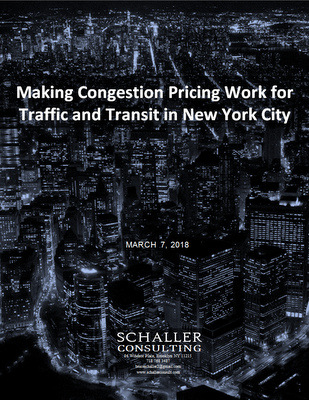|
Schaller Consulting |  |
| Home | New Mobility | Taxi, Traffic & Transit (Archive) |
 Full report: Making Congestion Pricing Work for Traffic and Transit in New York City (pdf file)
Full report: Making Congestion Pricing Work for Traffic and Transit in New York City (pdf file)The rise of app-based ride services such as Uber and Lyft in major U.S. cities raises the question of what should be done to control the traffic impacts from their rapid growth without compromising the mobility benefits they bring to city residents. Among a range of policies are often suggested, the focus often turns toward congestion pricing. Wouldn't charging companies and customers for their use of oversubscribed streets be the best solution? This question is in the spotlight in New York City as the recommendations of Gov. Andrew Cuomo's FixNYC task force are discussed in Albany. How, when and where should a surcharge on Uber, Lyft and other for-hire services including yellow cabs be applied? How effective would a surcharge be in reducing traffic? Can a policy avoid being seen as "too expensive" and at the same time make a difference in providing traffic relief? "Making Congestion Pricing Work for Traffic and Transit in New York City" takes these questions head-on. The report is the first in-depth analysis of how to apply pricing to new mobility services, often called "Transportation Network Companies" (TNCs). The report recommends that a surcharge on taxi/for-hire trips in central Manhattan be applied as an hourly charge. An hourly fee would have several advantages over a per-trip fee as currently being discussed. It would provide strong incentives:
The report recommends that the hourly fee be higher in Midtown Manhattan which chronically has the most severe congestion in the CBD and also has a wealth of transit, walking and biking options. A fee of $50/hour in Midtown and $20/hour elsewhere in Manhattan (up to East 96 and West 110 St.) would reduce TNC and taxi trips by 8 percent and mileage by as much as 30 percent, depending on how much TNCs and taxis reduce vacant time between trips. This would provide substantial immediate traffic relief to Manhattan streets. It would also provide an immediate infusion of $670 million annually for improved subway and bus service and other transportation needs. While $50/hour seems quite high at first glance, a fee of this magnitude is essential to providing effective traffic relief. The main reason that relatively few people drive into Midtown Manhattan is the high cost of garage parking, roughly $25 to $35 or more per day. A $50/hour surcharge translates to an additional $14 per trip on taxi and TNC fares, making round-trip use of taxis/TNCs equivalent to the cost of parking. This fee would be targeted on Midtown trips, which comprise a tiny 0.6 percent of all taxi/TNC trips citywide. For other trips in Manhattan, the average taxi/TNC fare would increase from $13 to $21. Passengers could offset this surcharge by electing UberPool, Lyft Line or Via instead of taking a solo TNC trip. These trips comprise 29 percent of all taxi/TNC trips citywide. The report also recommends that an hourly charge be applied to trucks operating in the CBD. An hourly fee for trucks would be more directly gauged to their contribution to CBD congestion and would incentivize more efficient operations, such as increasing staff on each truck to make deliveries more quickly. It could also be structured to reduce double-parking and "blocking the box," two common and unnecessary sources of traffic congestion. Other key findings from the report are:
Press coverage
Follow @Bruce_Schaller
|